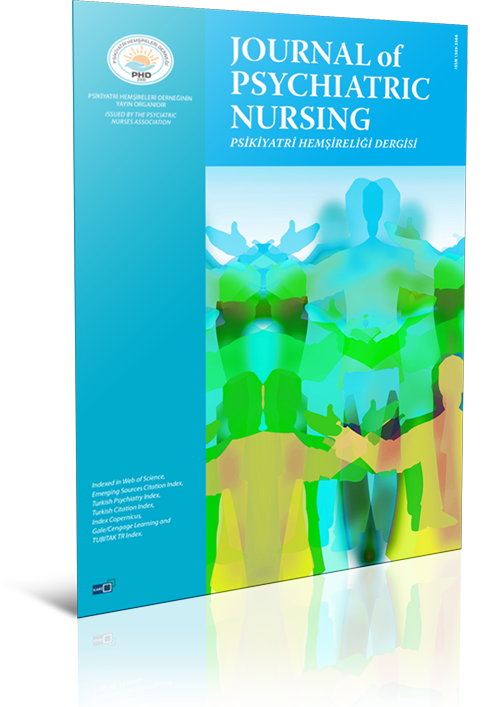
Volume: 4 Issue: 1 - 2013
| 1. | Frontmatter Pages I - III |
| RESEARCH ARTICLE | |
| 2. | Hopelessness and Healthy Life Style Behaviors In Patients With Coronary Artery Disorder Ayşegül Savaşan, Mine Ayten, Oktay Ergene doi: 10.5505/phd.2013.07279 Pages 1 - 6 Objective: The aim of this study was to evaluate hopelessness and healthy life style behaviors, effective factors and to determine the affect of hopelessness on healthy life style behaviors in Coronary Artery Disease patients. Methods: The study was conducted in 175 patients with coronary artery disease at the Izmir Ataturk Education and Research Hospital between October 2009 and January 2010. The patients were evaluated with Healthy Living Style Behaviors Scale (HLSBS), Becks Hopelessness Scale (BHS) and Information Form. Percentage, average, standard deviation and Correlation Analyses were used in evaluation of data. Results: The average age was 57±11. 77% of them were men and 23% of them were women; 41% were elementary school graduates and 77% were married. Total HLSB score average of patients was 128±22. HLSB sub scale score averages on the other hand were as follow: health consciousness 21±5; physical activity 14±5; nutrition 22±5; spiritual development 26±5; stress management 19±4; relations with others 27±5. BHS score average was 7±5. A weak relationship on the negative side has been determined between hopelessness and total HLSB (r= -0.261, p=0.00), physical activity (r= -0.247, p=0.00), spiritual development (r= -0.355, p=0.00), interrelationships (r= -0.154, p=0.04) and stress management (r= -0.205, p=0.00) upon examination of relationship between the HLSB score averages and BHS scores. As the score of hopelessness increases, scores of HLSB, physical activity, spiritual development, relations with others and stress management decrease. Conclusion: It was suggested the constitution of educational and rehabilitation programs for making patients conscious of healthy living and increasing healthy living style behaviors. |
| 3. | The Development and Psychometric Evaluation Study of Self-Efficacy for Protecting Adolescences from Substance Abuse Scale Fatma Eker, Dilek Akkuş, Özge Kapısız doi: 10.5505/phd.2013.74936 Pages 7 - 12 OBJECTIVE: The purpose of the study was to develop a scale in order to measure perceived self-efficacy beliefs of high school students regarding protecting themselves from substance abuse. METHODS: 1100 ( 526 female, 524 male) high school students participated in the validity and reliability studies. Content analysis and exploratory factor analysis was applied in validity study. Item discriminations were tested and determined the reliability of scale Cronbach Alpha internal consistency coefficient were calculated. RESULTS: Self-Efficacy for Protecting Substance Abuse Scale was explained 50.3% of the total variance. The scale was composed of 24 items with four factors and one control item. Regarding to experts opinion sub scales were named as Staying Away from Drugs/ Stimulant Drugs- General (12 items), Staying Away From Drugs/ Stimulant Drugs- Under Pressure (4 items), Help-Seeking about Drugs/ Stimulant Drugs (4 items), Supporting a Friend about Drugs/ Stimulant Drugs (3 items). Cronbach internal consistency coefficient of the whole scale was found to be.81. Internal consistency of sub scales were ranged.45-.87. Test-retest correlation was significantly positively correlated (p<0.001). CONCLUSION: These results suggest that 24-item scale for high school students is a reliable and valid measure with four sub-scales. We advocate further research to find out the validity of the scale among individuals from different socioeconomic and education settings. Finally, Self-Efficacy for Adolescences Protecting Substance Abuse Scale may provide useful practical information to measure effectiveness of substance abuse prevention programmes. |
| 4. | Levels of Comminaciation Skills of Service Education Nurses Hanife Tiryaki Şen, Feride Taşkın Yılmaz, Özlem Pekşen Ünüvar doi: 10.5505/phd.2013.70188 Pages 13 - 20 OBJECTIVE: The research was carried out to determine communication ability levels of in service education nurses and personal and professional characteristics which affect this skills. METHODS: The research was done descriptive and cross-sectional in between 12 June- 30 June 2009. The study population included 123 in service education nurses working in public hospitals and primary health services in Istanbul. It was included in sample 91 in service education nurses who accepted to participate and filled out data collection tool completely. Datas were collected by using information form which contained personal and professional characteristics and communication skill scale. Percentage, t-test, one-way ANOVA and Pearson correlation analysis were used in statistical analizing. RESULTS: Average years of age of in service education nurses was established 35.07-5.18, 97.8 % of tham were female, 83.5% were married, 72.5% had a child, 41.8 % gradueded associate degree, 35.2 % worked in primary health services, 37.4% had been working in profession for 16-20 years. It was determined 71.4% of participants had been working as in service education nurses for 1-5 years and 53.8 % of those had additional tasks besides in service education nursing. Average point of communication skills of in service education nurses was found 189.45-14.02. It was determined that age, marital status, having a child, education level, professional experience lenght, in service education nursing period and existing of additional tasks didn't affect communication skills (p>0.05). CONCLUSION: It was established that communication skills of in service education nurses which are important to improve professional knowledge and skills of nurses in health services were generally well and personal and professional characteristics didn't affect communication skills. |
| 5. | Living with a husband on hemodialysis: Tides in the life of wives Meltem Meriç, Fahriye Oflaz doi: 10.5505/phd.2013.96268 Pages 21 - 26 OBJECTIVE: The purpose of this study was to explain the experiences, feelings and perceptions of the wives of hemodialysis patients. METHODS: The study was performed between February 10 and May 15, 2008 in the nephrology department of a training hospital. A total of 12 wives who were willing to participate in the study constituted the study sample. The phenomenological design and interpretation was used. Data were collected by in-depth one-to-one interviews by using a semi-structured interview guide. Each interview lasted 45-50 minutes and was tape-recorded. Colaizzis interpretation method was used for data analysis. RESULTS: Wives of hemodialysis patients talked about the tides in their lives according to the patients medical condition and feelings. For this reason, THE TIDES was the main theme describing their experience. Almost all the wives stated that all aspects of their own lives such as feelings, experiences and thoughts were changing or fluctuating like the tides according to the patients feelings, experiences and thoughts. They were experiencing fluctuations between being a wife and a caregiver. Other fluctuations were between the meaning of hemodialysis as hope or hopelessness and fluctuations between dependence and independence. In addition, they questioned whether hemodialysis was a treatment or health problem. Their feelings and lives were changing and fluctuating based on the patients' perceptions and problems in the continuum of the treatment process. CONCLUSION: The hemodialysis process causes many changes in the lives of the wives who share every aspect of their husbands lives as well as the patients themselves. The wives stated life is experienced together. They need supportive help to facilitate living with their husbands on hemodialysis. |
| 6. | Levels of Death Anxiety, Death Related Depression of Health Personnel Providing Emergency Medical Services and Their Coping Methods Gülten Acehan, Fatma Eker doi: 10.5505/phd.2013.07379 Pages 27 - 35 OBJECTIVE: This study has been carried out descriptively with the purpose to specify the death anxiety and death related depression of health personnel providing emergency medical services in Province of Düzce and their coping methods. METHODS: Sample of study was 141 (78F, 63M) health personnel working in emergency medical services providing institutions found within the borders of the Province of Düzce. Research data has been collected by applying Introduction Form, Templer's Death Anxiety Scale and Death Related Depression Scale tests, KruskalWallis variance analysis, Mann-Whitney U test and correlation coefficient have been used in the statistical analysis of data. RESULTS: Death anxiety in emergency medical personnel is low and death related depression was at a medium level; death anxiety and death related depression scores of women were higher in comparison to men. Death anxiety levels and death related depression scores of personnel using inneffective coping methods were higher. It has been found that there were significant relation between death anxiety and death related depression and significant relation between duration of working in emergency medical services and death related depression positively. CONCLUSION: In this study it has been found that personnel working in emergency medical services need psychological counseling and education about effective coping methods with death fact. |
| CASE REPORT | |
| 7. | Termination In Psychotheraphy: A Case Report Which Consists Of The Difficulties In Termination Phase Nurhan Eren doi: 10.5505/phd.2013.99608 Pages 36 - 45 In this paper, the termination phase in psychotherapy is discussed and a case report of a psychotherapy process which consists difficulties in termination phase is presented. Personality structure of this case displays high-level borderline organization and diagnosis major depression according to Axis I and histrionic personality disorder and schizoid personality features according to Axis II of the Diagnostic and Statistical Manual (DSM-IV). In this patient individual art psychotherapy with psychodynamic orientation was used. In the first year of psychotherapy process the patient, by developing a positive transference for the therapist, idealized her and reflected therapist needs for ideal motherhood/self-object. The utilization of art therapy (painting) functioned as a container that holds traumatic and chaotic inner lives of the patient. It served as a means for the dyadic relationship formed with painting therapy and thereby allowed to repair narcissistic structure and to improve him/her. In this stage, depressive symptoms were resolved through fulfilling the patients need of self-object. However, in later stages when patient realized the limits of the therapy/therapist, a feeling of disappointment occurred and it revealed the patients struggle of separation-individualization and desire to terminate the psychotherapy process. At the same time, this process triggered patients efforts to perceive herself as an individual. In the third year the patient terminated the process of therapy without even informing the therapist in a way that can be considered as acting out response and only one year later the patient completed the process through coming for an interview with the therapist. In this case patients object relationships, difficulties about the separation and especially the effects of psychotherapy that continued after completing the process were presented. |
| REVIEW | |
| 8. | The Socio-Cultural Factors That Affect Violence To Health Care Personnel Ayşe Büyükbayram, Hale Okçay doi: 10.5505/phd.2013.14622 Pages 46 - 53 The violence to health care workers has increased recently. This adversely affects the relation between health care workers and patients and their care givers and results in decline in motivation of the health care personnel and the quality of the service that they offer. Psychological problems may appear and it even leads to the resignation. This study aims to display the socio cultural reasons that influence violence to health care personnel and factors that contribute to the development of precautions which help the elimination/minimizing of the violent acts and its nature, development and emergence in accordance with the literature. |
| TEZ TANITIM | |
| 9. | Mental status evaluation of patients with chronic kidney disease Elif Ok Page 54 Abstract | |
| SCALE PRESENTATION | |
| 10. | Kişilik Bozukluğu Hastalarına Karşı Tutumlar Ölçeği (KBH-TÖ) Nurhan Eren Page 55 Abstract | |


















